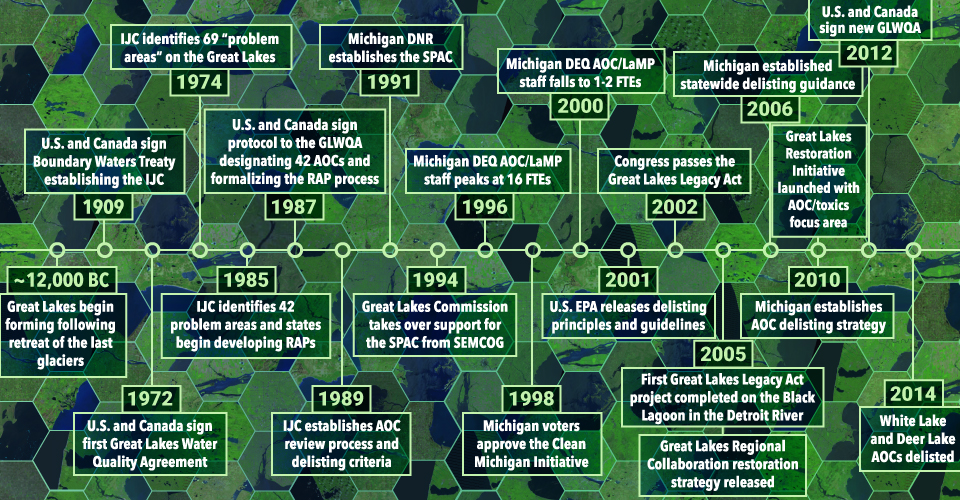Cleaning up the past for a brighter, ‘bluer’ economic future in Michigan
Michigan's 'blue economy' presents plenty of opportunities for Michigan's economic future. But first, the state must clean up the sins of its economic past.

These days, there’s plenty of optimistic talk on the potential of Michigan’s “blue economy”—the idea that the economic future of the state rests on its greatest natural resource: the Great Lakes. Economic developers and government officials envision a future of water-based tourism and clean water technology research and development.
But securing a future economy based on clean water requires that we address the water pollution legacy of Michigan’s economic past.
In the early and middle twentieth century, Michigan’s manufacturing and mining industries poured chemicals and waste into the Great Lakes. At the time, there was limited understanding of the consequences of such actions. The maxim “dilution is the solution to pollution” was the prevailing wisdom. People believed the environment would ultimately absorb and clean the toxins it received.
It wasn’t until the Clean Water Act of 1972 that industry began to clean up under the auspices of federal regulation. Around the same time, municipalities began to improve their wastewater treatment under the law. Many once-polluted areas began to recover on their own. Fish and wildlife returned. Once-brackish waters ran clear.
But in some areas, the damage was beyond what nature could repair itself. Toxins deposited in bottom sediments worked their way up the food chain, impairing fish and wildlife, destroying economic value and taking away the ability for people to enjoy water-based recreation.
By 1987, it was evident some of these areas weren’t going to get better on their own.
The worst of the worst
In Michigan’s Upper Peninsula, Deer Lake near Ishpeming had been polluted for as long as anyone could remember.
“Let’s take ourselves back to 1800s, when state surveyors were roaming around the state, trying to figure out what’s where. They get to Ishpeming and they see gold. Later they notice iron ore,” says Mark Loomis, Environmental Scientist with the U.S. EPA Great Lakes National Program Office.
Soon enough, Loomis says, open pit mines and a town sprang up along the shores of Deer Lake. Later, miners discovered that the most productive ore was located just beneath the city.
“They dug down below the town, several thousand feet in some places, to get to the iron,” Loomis says. “They sent it to Duluth, made steel and then it went out to New York to make skyscrapers. Imagine the Empire State Building upside down underneath the city.”
For a time, the town and the industry flourished, but eventually, ore production stopped. The town was left sitting atop a network of tunnels connected to surface pit mines, and the whole thing slowly began to fill in with groundwater. This was made worse when the city, to avoid flooding, diverted a nearby creek into one of the surface mines.
“Imagine one of those iron teapots, like you see at P.F. Changs,” says Loomis. “You’ve got that iron teapot. It holds the water in. The iron ore underneath Ishpeming is just like that. It’s so pure it’s really hard for water to travel through it. All those tunnels are like the inside of the teapot. We were pouring water into the spout of the teapot and so much water got in, it started coming out the top.”
To avoid having the teapot spill over, the city pumped water out of the mines and into a Carp Creek, which flows into Deer Lake. The end result: a sort of liquid conveyor belt in which clean, tannin-rich creek water flowed through the old mineshafts, picking up mercury from the dynamite used to blast the mines, and depositing it into Deer Lake.
The results: toxic fish and reproductive problems in birds and animals, including bald eagles. On top of that, the lake became eutrophic—fueled by nutrients in the city’s poorly treated wastewater —which further harmed fish populations and caused algae blooms.
In 1987, Deer Lake was placed on a list of the ‘worst of the worst’ environmentally contaminated areas in the Great Lakes.
Michigan’s ‘Areas of Concern’
In 1987, 43 “toxic hot spots” around the Great lakes were designated as “Great Lakes Areas of Concern” (AOCs) by the United States and Canada under the binational 1987 Great Lakes Water Quality Agreement. Fourteen of those areas were in Michigan.
Click on the purple areas in this map to see which beneficial use impairments (BUIs) remain and which have been removed for each AOC.
Map data source: USEPA. Acquired with the assistance of ECT Inc.
Some of the areas had a history like Deer Lake’s—pollution from natural resource extraction. Others were impacted by industry—from paper mills to automotive manufacturing. Some were impacted by urbanization. They all had one thing in common: There was very little chance that they could recover without some serious help.
“We’re trying to achieve a level of cleanliness to the water that makes it fishable, swimmable, and drinkable,” says Mary Bohling, chair of Michigan’s Statewide Public Advisory Council, which oversees and coordinates the activities of local public advisory councils (PACs) in each AOC. “We want to put it back to a level where we’re no worse than other surrounding areas that are not designated as an area of concern.”
The AOC program got underway in the late 1980s and 1990s with a focus on defining the problem. Each AOC identified which of 14 “Beneficial Use Impairments” (BUIs) it was impacted by. Remedial Action Plans (RAPs) were developed for each area. But little funding was available to implement those plans.
One of the most significant problems was that there was little consensus on what restoration looked like; how would an AOC know when to stop being an AOC?
“By the late ’90s, the program was really kind of languishing,” says Matt Doss, Policy Director for the Great Lakes Commission (see Q&A at right). “There wasn’t much progress. We didn’t have much to show for it. Very little dedicated funding was going into the program, and there just wasn’t a lot happening. People were perceiving that the program was not generating much progress or success.”
So in the early 2000s, EPA’s Great Lakes National Program Office began pushing Great Lakes states to develop delisting targets for how the BUIs could be removed.
“There was a realization that there were no targets for any of the AOCs, even though they had been in place, by then, for more than fifteen years,” says Sanjiv Sinha, Ph.D., an environmental consultant with Environmental Consulting & Technology (ECT) Inc. who worked on developing delisting targets for AOCs in Michigan. “The question was, how would you know, when you got there, that you actually did clean up an Area Of Concern?”
Sinha began by developing delisting targets for Michigan’s most populated Area of Concern, the Clinton River, in 2006. He subsequently worked with other AOCs across the state and the Great Lakes region to do similar work. The MDEQ published guidance and strategies for delisting criteria in 2006 and 2008.
Finally, local PACs had a roadmap to ‘get to delisting.’
One obstacle remained: finding the money to fix the problems.
Funding the fixes
The fixes to the problems in Areas of Concern are not cheap. The things that need to be done— removing (and disposing of) massive amounts of toxic sediment, restoring badly impacted habitat and decommissioning dams—are very costly.
The program got a boost in 2002 with passage of the Great Lakes Legacy Act, which dedicated funding specifically to address contaminated sediments in AOCs. The act was renewed in 2008. According to EPA documents, $338 million in federal funds has leveraged an additional $227 million from non-federal sponsors to remove or remediate 4 million cubic yards of contaminated sediments at 19 sites since the program began.
“The Legacy Act was important for gaining momentum so far as the removal of legacy sediment,” says Sinha. “But the overall restoration program took off in a big way in 2010 with the Great Lakes Restoration Initiative.”
The GLRI is a federal funding program launched in 2010. According to an EPA report, more than $1.6 billion was spent between 2010 and 2014 on AOC restoration work. Over that time period, 42 BUIs were removed in 17 Areas of Concern. That’s quadruple the number removed in the preceding 22 years.
“Prior to GLRI, there were a lot of great people with great ideas, a lot of sound science, and a lot of planning,” says Bohling. “All of that planning was a great foundation, so that when GLRI came onboard, we were well-positioned to just hit the ground running, and start ticking off those projects.”
Life after delisting
Deer Lake was officially delisted on October 30, 2014. The restoration included an $8 million project that diverted water from the underground mine to the surface, where it was redirected to restore Partridge Creek. The stream now supports trout.
“I think this is a great example of a community being invested in their AOC and understanding its issues,” says Loomis. “They had their ducks in a row. Decades of hard work and planning and thinking that they went through paid off.”
As of June, 2015, 36 BUIs have been removed from Michigan AOCs and two areas have been entirely delisted (Deer Lake and White Lake). If current plans stay on track and are funded, seven more AOCs will be delisted by 2019 (Clinton River, Manistique River, Menominee River, Muskegon Lake, River Raisin, St. Clair River and St. Marys River).
But just because the areas have been delisted from the AOC program doesn’t mean there aren’t still problems to fix and ways to make things even better. In many of these areas, citizens and local officials have been working together for decades, and they see many more issues to tackle beyond BUIs. But once an AOC is delisted, it is no longer eligible for GLRI funding.
This all leads to a bit of an identity crisis known in AOC circles as “life after delisting.”
“I think being an AOC, right now, with GLRI definitely is an advantage as far as funding goes,” says Bohling.
Right now, local PACs are starting to grapple with what happens when they no longer have access to that funding. What does “life after delisting” mean?
Melanie Foose coordinates local Areas of Concern for the MDEQ. She is working with the River Raisin to figure out how to carry on the work of the local PAC.
“The City of Monroe Commission on Environment. and Water Quality (COTE) recently organized and hosted a strategic planning workshop to discuss what’s next for the River Raisin under four categories; maintenance, recreation, water quality and habitat,” she says. She hasn’t seen other AOCs do this yet, and hopes more, particularly those set to delist in the next 5 years, will be thinking this way in the near the future.
He points to studies that have linked GLRI funding directly to economic benefit in the present. One study estimates as much as a 3-to-1 return rate for every dollar spent on Great Lakes Restoration. Another study shows as much as a 6-to-1 return rate for cleaning up Muskegon Harbor.
“Based on these findings, it’s not a surprise that continued clean-ups and restoration are a bipartisan congressional priority,” says Sinha. “Sound economics and the diligence of scores of volunteers over so long a period of time are aligned.”
This series about restoration in Michigan’s Areas of Concern is made possible through support from the Michigan Office of Great Lakes through Great Lakes Restoration Initiative.






